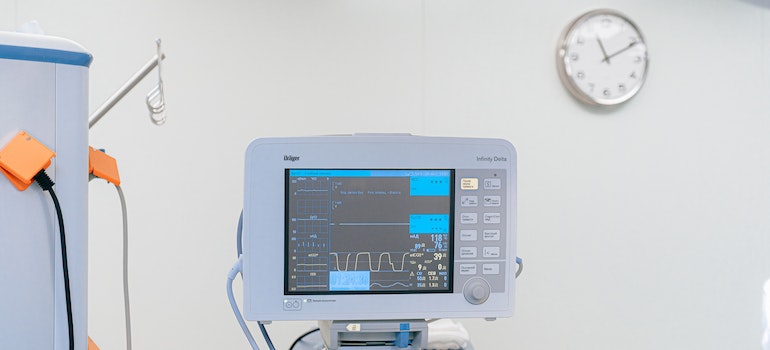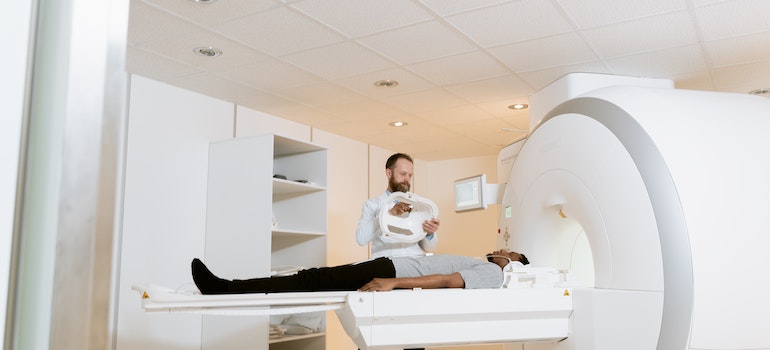Global access to life-saving technology: Shipping medical equipment made easy
Access to life-saving medical technology is critical in the healthcare industry, and ensuring the safe and timely delivery of medical equipment is essential for patients to receive the care they need. This article provides an overview of the importance of medical equipment shipping, the challenges healthcare providers face, and tips for ensuring safe and efficient shipping. Our team at Peasley Moving & Storage Boise has dealt with shipping medical equipment for many years and has extensive knowledge of it. With their expertise, we will discuss the importance of choosing a reputable shipping provider and provide strategies for ensuring safe and timely deliveries.
Importance of Shipping Medical Equipment
Medical equipment is essential to the healthcare industry, as it helps healthcare providers diagnose and treat patients. Without access to medical equipment, healthcare professionals would be unable to accurately diagnose illnesses or provide the necessary treatments. In addition, medical equipment plays a crucial role in research and development, enabling scientists to make new discoveries and develop new treatments.
The global demand for medical equipment is high, and healthcare providers around the world rely on the timely delivery of medical equipment to ensure that patients receive the care they need. However, shipping medical equipment is not as simple as shipping other types of products. Consequently, medical equipment shipping services are becoming more common within the transportation industry. These services require highly trained individuals, this is why you need to do a lot of research before opting for a shipping company.

Challenges Faced by Healthcare Providers
Shipping medical equipment presents several challenges for healthcare professionals. First, medical equipment is often large, heavy, and fragile, and must be handled with care to prevent damage during transit. Second, medical equipment is often expensive, and any damage or loss can be costly. Third, medical equipment is subject to various customs and regulatory requirements, which can vary by country and region. Finally, medical equipment is often urgent, and any delays in delivery can have serious consequences for patient care.
Factors Affecting Medical Equipment Shipping
Shipping medical equipment is subject to several factors, including the:
- type of equipment being shipped,
- the chosen transportation modes and routes, and
- the applicable customs and regulatory requirements.
Each of these factors can impact the shipping process and require careful consideration to ensure safe and timely delivery. By understanding these factors, healthcare professionals can better navigate the logistics of medical equipment shipping.
Types of Equipment
The size, weight, and fragility of medical equipment can significantly impact the shipping process. You must carefully consider the type of equipment you are shipping in order to determine the appropriate packaging and transportation methods. For instance, shipping a large and heavy MRI scanner may require special handling and transportation equipment, while smaller and less delicate equipment like a portable ultrasound machine may be shipped via standard shipping methods.
Transportation Modes and Routes
The transportation mode and route used to ship medical equipment can also affect the shipping process. For example, shipping by air is often faster than shipping by sea but may be more expensive. Shipping by road may be faster than shipping by sea or air for certain destinations but may not be possible for others. The length of the trip can be unpredictable and that can affect medical equipment.

This is why the medical equipment you’re shipping needs to be in appropriate storage. If you store your medical equipment in unsuitable storage, you’re risking damage during transit. Be sure to look into the heated storage Boise medical institutions use when transferring their medical equipment. Heated storage is best suitable for items that need to be kept at a certain temperature, such as medical equipment.
Customs and Regulatory Requirements
Medical equipment is subject to various customs and regulatory requirements, which can vary by country and region. For example, some countries require specific documentation or certifications for medical equipment, while others may restrict certain types of equipment altogether. Healthcare providers must be aware of these requirements in order to avoid delays or complications in delivery.
Tips for Healthcare Providers
Not a lot of healthcare professionals have insight knowledge of shipping containers overseas, that is why our team has done extensive research on medical equipment shipping and we have prepared some tips for you. Shipping medical equipment can be a complex process, and there are several steps that healthcare providers can take to ensure that their vital equipment is delivered safely and on time.
Understand the logistics of medical equipment shipping
Healthcare providers should familiarize themselves with the various factors that can affect the shipping process, including the types of equipment being shipped, transportation modes and routes, and customs and regulatory requirements. This will help them better understand the shipping process and anticipate potential challenges.
Proactive communication with the shipping provider and recipient
Proactive communication is essential for ensuring a smooth and timely shipping process for medical equipment. Healthcare providers should maintain regular contact with both the shipping provider and the recipient to ensure that all parties are aware of the shipment’s progress and any potential delays or issues. This communication can help to prevent misunderstandings, delays, or complications during the shipping process. By staying in close contact with the shipping provider, healthcare providers can also address any concerns or questions they may have about the shipment and ensure that it is progressing as planned.
Contingency planning for unexpected delays or complications
Contingency planning is also crucial for healthcare providers shipping medical equipment. Unexpected delays or complications can occur during transit, such as inclement weather, traffic, or mechanical issues with the shipping vehicle. To minimize the impact of such events, healthcare providers should have contingency plans in place, such as backup transportation options or alternative delivery locations. By having a plan in place, healthcare professionals can quickly adapt to unexpected changes in the shipping process and ensure that the equipment arrives at its destination as scheduled.
Benefits of Working with a Trusted Provider
Working with a trusted medical equipment shipping provider is crucial for healthcare providers looking to transport their critical equipment. By choosing a reputable provider, healthcare professionals can reap several benefits that can improve the efficiency and safety of their shipping process.

Improved Efficiency
One of the most significant benefits of working with a trusted provider is improved efficiency. A provider with experience in shipping medical equipment can help healthcare providers navigate the various challenges of international shipping, such as customs clearance and regulatory compliance. This can help avoid costly delays and ensure that equipment is on time to support patient care.
Reduced Risk of Damage or Loss
In addition to improved efficiency, partnering with a trusted provider can also reduce the risk of damage or loss. Medical equipment is often fragile and sensitive, requiring specialized packaging and handling to ensure that it arrives at its destination intact. A reputable shipping provider will have experience and expertise in handling medical equipment and can help ensure that it is properly packaged and labeled to prevent damage or loss during transit.
Peace of Mind for Healthcare Providers
Perhaps most importantly, teaming up with a trusted medical equipment shipping provider can offer healthcare providers peace of mind. Knowing that their vital equipment is in good hands can alleviate the stress and uncertainty that can come with shipping sensitive equipment across the globe. With a trusted shipper, healthcare professionals can be sure that their equipment will arrive safely and on time, allowing them to focus on providing the best possible care for their patients.
Strategies for Ensuring Safe and Timely Delivery
To ensure that medical equipment is safe and on time, healthcare providers should implement specific strategies. Some of the strategies we’ll mention are proper packaging and labeling, proactive communication with shipping providers and recipients, contingency planning, and monitoring and tracking the shipment throughout the process. By taking these steps, it becomes easier to minimize the risk of damage or loss and ensure that the equipment arrives at its destination as scheduled.
Proper Packaging and Labeling
Proper packaging and labeling is essential to ensuring the safe delivery of medical equipment. It can be hard to find proper packing supplies in Boise, but it is essential to use specialized packaging materials or crates that are designed to protect the equipment during transit. The packaging should have labels with clear instructions and handling guidelines to prevent damage during shipping. These labels can include warnings for fragile or sensitive equipment, instructions for how to handle and transport the equipment, and contact information for the provider.

Proactive Communication
Proactive communication is also key to ensuring safe and timely delivery of medical equipment. Healthcare providers should maintain regular communication with the shipping provider and the recipient to ensure that all parties are aware of the status of the shipment and any potential delays or issues. This can include providing tracking information and updates on delivery times, as well as being available to answer any questions or concerns.
Using Inventory Storage
Another helpful strategy to consider when shipping medical equipment is using inventory storage. This type of storage can help when shipping medical equipment by providing a secure and climate-controlled environment for the equipment to be stored prior to shipping. By storing equipment in an inventory facility, healthcare professionals can ensure that their equipment has proper maintenance and protection from damage or loss.
Additionally, having inventory storage can help streamline the shipping process by allowing the pre-position of equipment at strategic locations, reducing transit time and costs. This can be particularly beneficial for international shipments, where customs clearance and regulatory requirements can be complex and time-consuming. By using inventory storage, healthcare providers can ensure that their equipment is ready for shipping and can be delivered quickly and efficiently to the intended destination.
Contingency Planning
Contingency planning is another important strategy to consider. They should have backup transportation options or alternative delivery locations in case of unexpected delays or complications. This can help to ensure that the equipment is on time, even if there are unforeseen issues with the original shipping plan.

Monitoring and Tracking
Finally, healthcare providers should monitor and track the shipment throughout the shipping process to ensure that it is on track and identify any potential issues that may arise. This can involve using online tracking tools or working with the shipping provider to provide regular updates on the shipment’s progress. By staying vigilant and proactive, it is easy to ensure that their vital equipment arrives safely and on time.
Choosing a Reputable and Reliable Medical Equipment Shipping Provider
Choosing a reputable and reliable medical equipment shipping provider is crucial to ensuring the safe and timely delivery of medical equipment. Healthcare providers should consider the following factors when choosing a provider:
- Industry certifications and compliance with regulations: The shipping provider should be certified by industry organizations such as the International Air Transport Association (IATA) or the International Maritime Organization (IMO), and should comply with all relevant regulations and customs requirements.
- Experience and track record with similar shipments: Choose a provider that has experience shipping similar types of medical equipment and can provide references or testimonials from satisfied customers.
- Network and capabilities for global shipping: Select a provider with a global network and the capability to ship to all necessary destinations, including those with complex customs and regulatory requirements.

Understand the logistics to ensure safe delivery
Today, medical equipment shipping plays a critical role in the healthcare industry. It is vital to ensure that equipment gets to its destination safely and on time to healthcare providers and patients around the world. Healthcare professionals face a range of challenges in ensuring the safe and timely delivery of medical equipment, including customs and regulatory requirements, transportation modes and routes, and proper packaging and labeling. However, by understanding the logistics of medical equipment shipping, choosing a reputable and reliable shipping provider, and following specific strategies for ensuring safe and timely delivery, healthcare providers can overcome these challenges and ensure that their patients receive the care they need.

